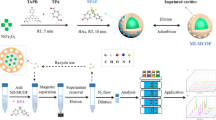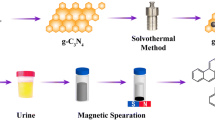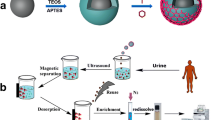Abstract
A novel magnetic borate-functionalized metal-organic framework nanocomposite was designed and fabricated for selective enrichment of catecholamines from human urine. Firstly, the polytannic acid (PTA) layer with natural low-cost and ecofriendly polyphenol tannic acid as the organic ligand and Fe3+ as the cross-linker was coated onto the surface of Fe3O4. Then, the borate-functionalized metal-organic framework (MIL-100(Fe)-B) with 5-boronobenzene-1,3-dicarboxylic acid as a ligand fragment was modified onto the PTA-coated Fe3O4 through a metal-ligand-fragment coassembly strategy. The obtained smart porous adsorbent Fe3O4@PTA@MIL-100(Fe)-B was confirmed by means of several characterization methods and then applied as an effective magnetic solid phase extraction (MSPE) sorbent for specific extraction of trace catecholamines in human urine. The Plackett–Burman design was used for screening the variables significantly affecting the extraction efficiency. Then, the significant factors were further investigated by the Box–Behnken design to determine the optimal extraction conditions. Under the optimal conditions, a method for selective MSPE combined with high-performance liquid chromatography with a fluorescence detector for the quantitation of catecholamines in human urine was developed and validated. With the proposed method, the linearity range was from 0.500 to 500 ng mL−1 for norepinephrine and epinephrine and from 1.00 to 500 ng mL−1 for dopamine. The detection limits were 0.050, 0.11, and 0.20 ng mL−1 for norepinephrine, epinephrine, and dopamine, respectively. The recoveries from spiking experiments varied from 91.5 to 108% with relative standard deviations (RSDs) of 0.80–4.8%. The established method is rapid, sensitive, accurate, inexpensive, and ecofriendly and was successfully applied to the determination of the target catecholamines in human urine samples.
Graphical abstract






Similar content being viewed by others
References
Ribeiro José A, Fernandes Paula MV, Pereira CM, Silva F (2016) Electrochemical sensors and biosensors for determination of catecholamine neurotransmitters: a review. Talanta 160:653–679
Vinoth V, Natarajan LN, Mangalaraja RV, Valdés H, Anandan S (2019) Simultaneous electrochemical determination of dopamine and epinephrine using gold nanocrystals capped with graphene quantum dots in a silica network. Microchim Acta 186:681
Goldstein DS, Holmes C, Lopez GJ, Wu TX, Sharabi Y (2018) Cerebrospinal fluid biomarkers of central dopamine deficiency predict Parkinson’s disease. Parkinsonism Relat D 50:108–112
Espina-Benitez MB, Marconi F, Randon J, Demesmay C, Dugas V (2018) Evaluation of boronate affinity solid-phase extraction coupled in-line to capillary isoelectric focusing for the analysis of catecholamines in urine. Anal Chim Acta 1034:195–203
Hou XY, Huang W, Tong YK, Tian MM (2019) Hollow dummy template imprinted boronate-modified polymers for extraction of norepinephrine, epinephrine and dopamine prior to quantitation by HPLC. Microchim Acta 186:686
Deng YN, Gao Q, Ma J, Wang CZ, Wei YM (2018) Preparation of a boronate affinity material with ultrahigh binding capacity for cis-diols by grafting polymer brush from polydopamine-coated magnetized graphene oxide. Microchim Acta 185:189
Le J, Sun T, Peng R, Yuan TF, Feng YQ, Wang ST, Li Y (2020) LC-MS/MS determination of plasma catecholamines after selective extraction by borated zirconia. Microchim Acta 187:165
Konieczna L, Roszkowska A, Niedźwiecki M, Baczek T (2016) Hydrophilic interaction chromatography combined with dispersive liquid-liquid microextraction as a preconcentration tool for the simultaneous determination of the panel of underivatized neurotransmitters in human urine samples. J Chromatogr A 1431:111–121
Jian ML, Huang HL, Li KC, Chuan LM, Li L, Jiang L (2021) A 3-min UPLC-MS/MS method for the simultaneous determination of plasma catecholamines and their metabolites: method verification and diagnostic efficiency. Clin Biochem 87:67–73
Altun M, Cakal C, Caglar P (2015) The development of methacrylic acid based monolithic discs used in the microfluidic chips for application in the determination of catecholamines. Sensor Actuat B-Chem 208:164–172
Graeme E, David G (2009) Irwin K. Simultaneous liquid-chromatographic determination of plasma catecholamines and metabolites Clin Chem 12:2223–2224
Li XG, Li S, Kellermann G (2016) Pre-analytical and analytical validations and clinical applications of a miniaturized, simple and cost-effective solid phase extraction combined with LC-MS/MS for the simultaneous determination of catecholamines and metanephrines in spot urine samples. Talanta 159:238–247
Liu Z, He H (2017) Synthesis and applications of boronate affinity materials: from class selectivity to biomimetic specificity. Acc Chem Res 50:2185–2193
Li QJ, Lü CC, Li HY, Liu YC, Wang HY, Wang X, Liu Z (2012) Preparation of organic-silica hybrid boronate affinity monolithic column for the specific capture and separation of cis-diol containing compounds. J Chromatogr A 1256:114–120
Xu YW, Wu ZX, Zhang LJ, Lu HJ, Yang PY, Webley PA, Zhao DY (2009) Highly specific enrichment of glycopeptides using boronic acid-functionalized mesoporous silica. Anal Chem 81:503–508
Li XL, He YJ, Ma YY (2016) Hybrid approach combining boronate affinity magnetic nanoparticles and capillary electrophoresis for efficient selection of glycoprotein-binding aptamers. Anal Chem 88:9805–9812
He MF, Wei YM, Wang R, Wang CY, Zhang B, Han L (2019) Boronate affinity magnetic nanoparticles with hyperbranched polymer brushes for the adsorption of cis-diol biomolecules. Microchim Acta 186:683
Zhang S, Tang YP, Chen YY, Zhang JC, Wei YM (2020) Boronic acid-modified polyhedral oligomeric silsesquioxanes on polydopamine-coated magnetized graphene oxide for selective and high-capacity extraction of the catecholamines epinephrine, dopamine and isoprenaline. Microchim Acta 187:77
Park J, Wang ZU, Sun LB, Chen YP, Zhou HC (2012) Introduction of functionalized mesopores to metal-organic frameworks via metal-ligand-fragment coassembly. J Am Chem Soc 134(49):20110–20116
Zhu XY, Gu JL, Zhu JY, Li YS, Zhao LM, Shi JL (2015) Metal-organic frameworks with boronic acid suspended and their implication for cis-diol moieties binding. Adv Funct Mater 25:3847–3854
Chen GS, Fang XA, Chen Q, Zhang JG, Zhong ZS, Xu JQ, Zhu F, Ouyang GF (2017) Boronic acid decorated defective metal-organic framework nanoreactors for high-efficiency carbohydrates separation and labeling. Adv Funct Mater 27:1702126
Dai HX, Lü WJ, Zuo XW, Zhu Q, Pan CJ, Niu XY, Liu JJ, Li H, Chen XG (2017) A novel biosensor based on boronic acid functionalized metal-organic frameworks for the determination of hydrogen peroxide released from living cells. Biosens Bioelectron 95:131–137
Xie Y, Liu Q, Li Y, Deng CH (2018) Core-shell structured magnetic metal-organic framework composites for highly selective detection of N-glycopeptides based on boronic acid affinity chromatography. J Chromatogr A 1540:87–93
Liu SC, Ma Y, Gao L, Pan JM (2018) pH-responsive magnetic metal-organic framework nanocomposite: a smart porous adsorbent for highly specific enrichment of cis-diol containing luteolin. Chem Eng J 341:198–207
He X, Yu Y, Li Y (2018) Facile synthesis of boronic acid-functionalized magnetic metal-organic frameworks for selective extraction and quantification of catecholamines in rat plasma. RSC Adv 8:41976–41985
Luo B, Chen Q, He J, Li ZY, Yu LZ, Lan F, Wu Y (2019) Boronic acid-functionalized magnetic metal-organic frameworks via a dual-ligand strategy for highly efficient enrichment of phosphopeptides and glycopeptides. ACS Sustain Chem Eng 7:6043–6052
Li ST, Qin YR, Zhong GQ, Cai CQ, Chen XM, Chen CY (2018) Highly efficient separation of glycoprotein by dual-functional magnetic metal-organic framework with hydrophilicity and boronic acid affinity. ACS Appl Mater Interfaces 10:27612–27620
Ejima H, Richardson JJ, Liang K, Best JP, Koeverden MP, Such GK, Cui JW, Caruso F (2013) One-step assembly of coordination complexes for versatile film and particle engineering. Science 341:154–157
Wang T, Ma BB, Jin AW, Li XG, Zhang XL, Wang WJ, Cai YQ (2018) Facile loading of Ag nanoparticles onto magnetic microsphere by the aid of a tannic acid-metal polymer layer to synthesize magnetic disinfectant with high antibacterial activity. J Hazard Mater 342:392–400
Wei J, Liang Y, Hu YX, Kong B, Zhang J, Gu QF, Tong YP, Wang XB, Jiang SP, Wang HT (2016) Hydrothermal synthesis of metal-polyphenol coordination crystals and their derived metal/N-doped carbon composites for oxygen electrocatalysis. Angew Chem 128:1–6
Li SJ, Cui JN, Wu X, Zhang X, Hou XH (2019) Rapid in situ microwave synthesis of Fe3O4@MIL-100(Fe) for aqueous diclofenac sodium removal through integrated adsorption and photodegradation. J Hazard Mater 373:408–416
Author information
Authors and Affiliations
Corresponding author
Ethics declarations
Conflict of interest
The authors declare no competing interests.
Additional information
Publisher’s note
Springer Nature remains neutral with regard to jurisdictional claims in published maps and institutional affiliations.
Supplementary Information
ESM 1
(DOCX 4887 kb)
Rights and permissions
About this article
Cite this article
Xing, Y., Li, J., Chen, M. et al. Tannic acid-directed synthesis of magnetic and boronic acid-functionalized metal-organic frameworks for selective extraction and quantification of catecholamines in human urine. Microchim Acta 188, 225 (2021). https://doi.org/10.1007/s00604-021-04852-8
Received:
Accepted:
Published:
DOI: https://doi.org/10.1007/s00604-021-04852-8




